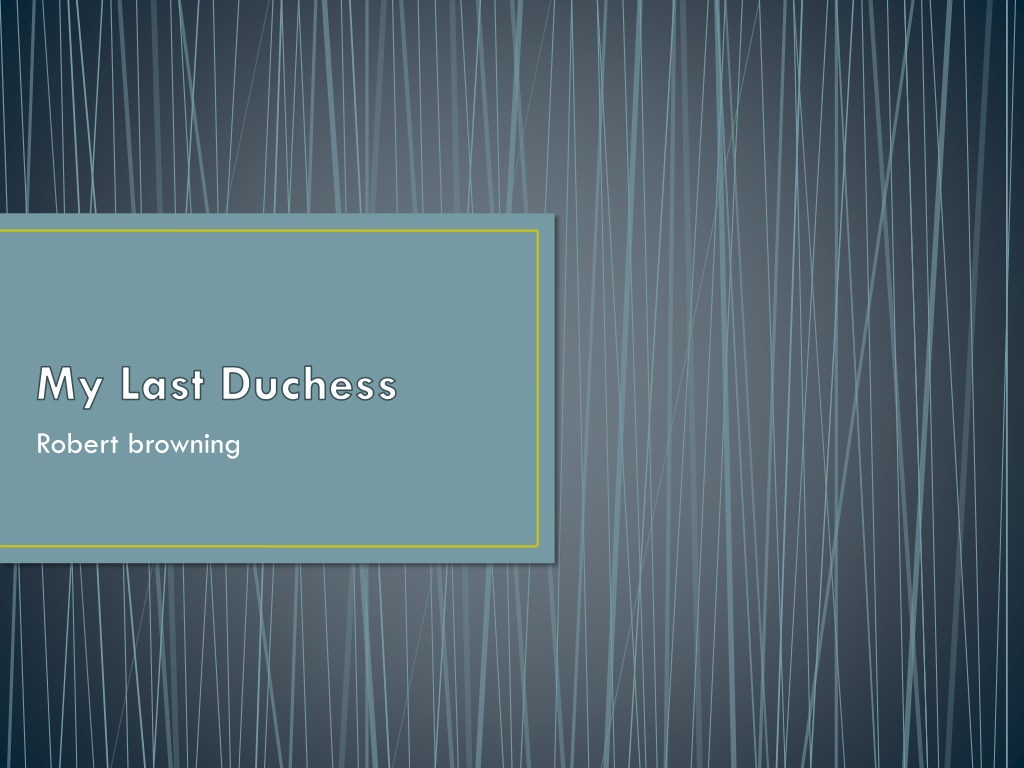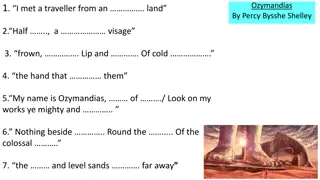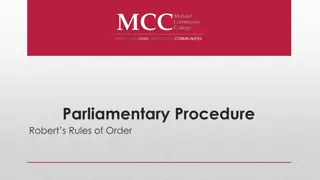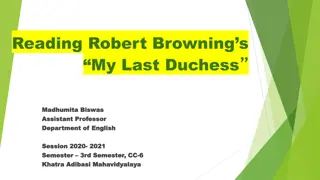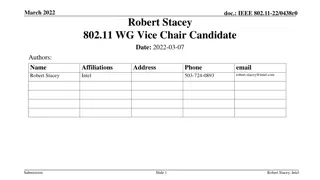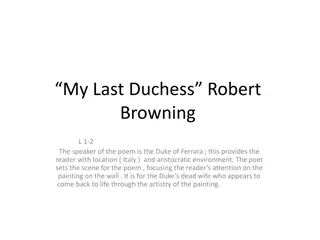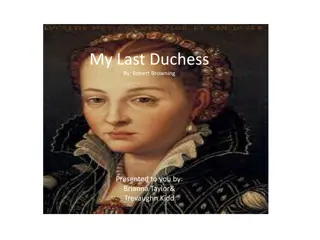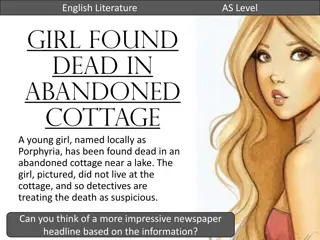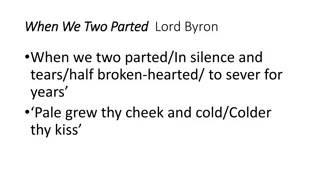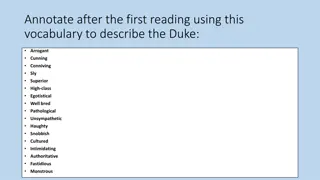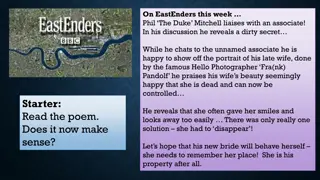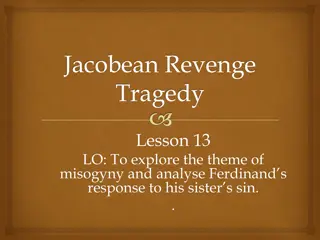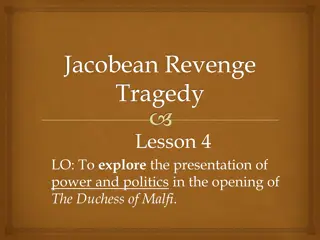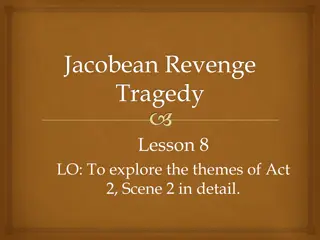Analysis of "My Last Duchess" by Robert Browning
The poem "My Last Duchess" by Robert Browning portrays the Duke of Ferrara showcasing a painting of his late Duchess to a visitor. Through the Duke's words, we uncover his controlling and possessive nature, highlighting his manipulation and jealousy over the Duchess's innocent demeanor. The Duke's remarks reveal his disdain for his late wife's independent spirit and his ruthless desire for power and control in his relationships. Browning skillfully delves into themes of art, power, and the objectification of women in this dramatic monologue.
Download Presentation

Please find below an Image/Link to download the presentation.
The content on the website is provided AS IS for your information and personal use only. It may not be sold, licensed, or shared on other websites without obtaining consent from the author. Download presentation by click this link. If you encounter any issues during the download, it is possible that the publisher has removed the file from their server.
E N D
Presentation Transcript
My Last Duchess Robert browning
Thats my last Duchess painted on the wall, 2.Looking as if she were alive. I call 3.That piece a wonder, now; Fra Pandolf s hands 4.Worked busily a day, and there she stands. 5.Will t please you sit and look at her? I said 6. Fra Pandolf by design, for never read 7.Strangers like you that pictured countenance, 8.The depth and passion of its earnest glance, 9.But to myself they turned (since none puts by 10. The curtain I have drawn for you, but I) A 1. . .
Alfonso shows the painting of his deceased Duchess exhibited on the wall. He feels that the image is alive and discerns the painting as a remarkable achievement. He reveals that the artist is Fra Pandolf who spent a day to complete the portrait. His artistry has resulted in the life like image of the Duchess and he asks the emissary to examine the painting
The poem immediately starts with the portrayal of Alfonsos last Duchess. The Duke is clear, crafty and aware of the words he is about to utter. Browning reveals later in the poem that the emissary visits the Duke to talk about marriage proposals. So, the Duke craftily walks him through to create an impression about him. Immediately, Alfonso tries to establish a negative impression on the Duchess so that he could gain from it. He presents himself as a lover of art and admires the work done by Fra Pandolf. But, his real intentions are shown when he expresses his thoughts about the Duchess. The Duke says that his mistress would blush at the presence of any man. One can also detect that the artist was given only one day to complete the painting indicating that the Duke is afraid about any advancements between his wife and the artist.
Alfonso tries to explain the smile on the face of his wife with the use of imaginary claims. He thinks that Fra Pandolf might have said that the cloak of the Duchess covers the wrists [a way of flirting] or remarking that such beauty can never be reproduced by paints. The Duke says that such words were enough to produce a smile on her face as she believed that they were the words of courteousness. She was the one who would derive gladness from anything quickly. She admired everything and her sight could derive happiness from everywhere.
The reader of the emissary does not know about the personality of the Duchess. But, Alfonso creates such psychological impact with his words that one would believe that the Duchess was unfaithful. His cynical remarks on how his last Duchess would be blushing in reaction to the words almost make it certain that she has sinful intentions in her mind
The Duke goes on to explain that three factors stood in his way for advising the Duchess he claims his inability to deliver a good speech than can change the predicament of his wife, even if he achieves it would be shameful if the wife gives out an excuse to escape and lastly Alfonso says that he will not be stooping down for anything. Alfonso admits to the emissary that his wife smiled at him as a mark of love, but he felt that the same smile was produced to anyone who passes her by. As this indiscriminate behaviour of the Duchess grew, the Duke couldn t bear it and gave orders to silence her. After narrating a compelling story about the death of his wife, the Duke shows the emissary the painting by Fra Pandolf where one can find the life like image of her.
The Duke resumes to business and asks the emissary to come with him to join the others. He emphasizes that the emissary s master a Count, is a rich man and he expects to get a good amount as dowry. However, Alfonso also states that the Count s daughter is more important to him than dowry. On the way down, Alfonso points out at another art piece Neptune taming a sea- horse. The bronze statue was made by Claus of Innsbruck.
The Duke is clever yet remorseless in his actions. The words I repeat suggest that the negotiations for dowry have been going on between him and the emissary. To make his point clear, the Duke used the story of Duchess to create a pitiful aura around himself and at the same highlight the name of his family. He does so successfully on several occasions. Further, his conversation with the emissary is also an indication to how life is going to be for the Count s daughter
The brilliant conclusion by Robert Browning clears the fog about the true nature of the Duke. His interest towards the bronze statue Neptune taming a sea horse reflects his interests in life. One can understand the Duke s point of view of a noble life is to live with superiority, unconditional dignity, snobbery and unstoppable power. Dramatic Monologue is similar to soliloquy in a drama, but Robert Browning has taken it to a more intimate level
His emphasis was always on the development of an individual, precisely psychological development. He has written many such poems but My Last Duchess is deservedly the best of his dramatic monologues for it depicts contrasting lives of a merry woman and a stern man. If the reader could understand every word of his works like My Last Duchess, it could lead to evolution of thoughts, personal growth and new understanding of the world.
And indeed, the question of cash is revealed at the top during a way that colors the whole poem. The duke almost employs his own sense of irony when he brings up a dowry to the envoy. This final stanza suggests that his story of murder is supposed to offer proactive warning to the lady he s soon to marry, but to offer it through a backdoor channel, through the envoy who would pass it along to the count who might then pass it to the girl.
After all, the duke has no interest in lecture her himself, as we ve learned! His irony goes even further when he reminds the envoy that he truly wants only the lady herself, whilst he s clearly stressing the importance of an outsized dowry tinged with a threat of his vindictive side.
Further, the duke shows a stimulating complication in his attitudes on class when he suggests to the envoy that they go Together down, an action not expected in such a hierarchical society. By no means can we justify the thought that the duke is willing to transcend class, but at an equivalent time he does allow a transgression of the very hierarchy that had previously led him to possess his wife murdered instead of discuss his problems together with her .
Thus this poem is complete package of browning s mastery over Psychology and art. THANK YOU
